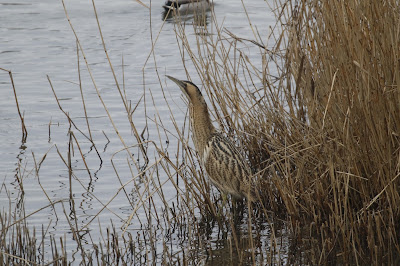Another day of freezing fog, ice slicked roads and yet another serious though thankfully non fatal road accident in Oxfordshire meant the cancellation of today's visit to relatives in London. Throughout the morning the fog persisted and out of casual interest I checked RBA(Rare Bird Alert) for news about our local bird celebrity, the Blue Rock Thrush, only to find there had been no sign of it for most of the morning.
It surely could not have flown off in all the fog that descended during the night so maybe it had succumbed to the extreme temperatures last night or less likely a local cat had caught it? At just on lunchtime I checked RBA again only to discover the thrush had been refound, having moved from Fisher Close where most people were looking for it, to a location some few hundred yards away just behind Stow's High Street.
At a bit of a loose end and knowing it was only a few minutes drive to Stow I decided to go for another look at the thrush as it will be very unlikely that I will ever have such an opportunity again. Also, I was a little unhappy at the images I had got on Tuesday and today I could try to rectify matters.
At 2pm it was still misty in my home village of Kingham as I left to drive towards Stow but just as before, on getting to the higher elevation of Stow the fog had dissipated and I found myself in welcome bright sunshine.
I parked along a side street and immediately saw some birders clustered in a tight scrum five deep and looking over a back garden gate to where the Blue Rock Thrush was perched on a house gable in the sunshine.
A tap on my shoulder and I was greeted by a twitching buddy I had not seen for some while, Donald, who with two friends had made the five hour drive from his home in Glasgow. We caught up on each others news and indulged ourselves in some birding banter and camaraderie before Donald had to set off back on the long drive to Glasgow
Meanwhile the thrush continued to sit on the roof but then flew to another and perched there giving me a superb opportunity to get some really nice images of it.
It chased an insect across the roof and then hopped up the roof tiles to the apex where it sat for a while before flying to another roof and perching on a chimney.
It moved regularly, between intervals of perching quietly, and we duly followed it but in the end I decided to go back to the garden and just wait there as it would surely return to the garden it was now so obviously favouring.
My plan came to fruition as it flew in a series of short flights from rooftop to rooftop to the garden, perching on the gable above the garden and then lower down on the guttering before flying down to the bird food scattered at ground level in the back garden.
Viewing conditions were extremely cramped looking over the closed iron gates into the back garden. The gates were bounded by high hedges on either side so really there was only room for three of us to view the bird at the gate while others peered through gaps in the hedge as best they could. There was a bit of mild complaining from people behind us that they could not see but in fairness I felt no guilt as I had secured my place at the front simply by opting to remain at the gate and foregoing seeing the bird on the surrounding houses.
I did not hog my position although there are many who would and regularly invited others to stand in front of me for a few minutes to view the thrush and eventually relinquished my position permanently. The thrush had sat for ages on the guttering before finally flying down to feed. Two Starlings thought they would join it but were seen off in no uncertain fashion by the thrush which rushed threateningly at them.
On the ground the blue in its plumage was much more noticeable and it really was a pretty bird. With the closer views today I also noted that the narrow white feather fringes to its body feathers were not restricted to just the breast and flanks, and the flight feathers were very obviously tipped dull white.
The sun was slowly being obliterated by the mist or was it fog rising from the lower ground below Stow and by 3pm it was beginning to get really dense. It was time to go and I left the thrush still feeding. I will definitely pay another visit tomorrow if the weather is suitable.


























































